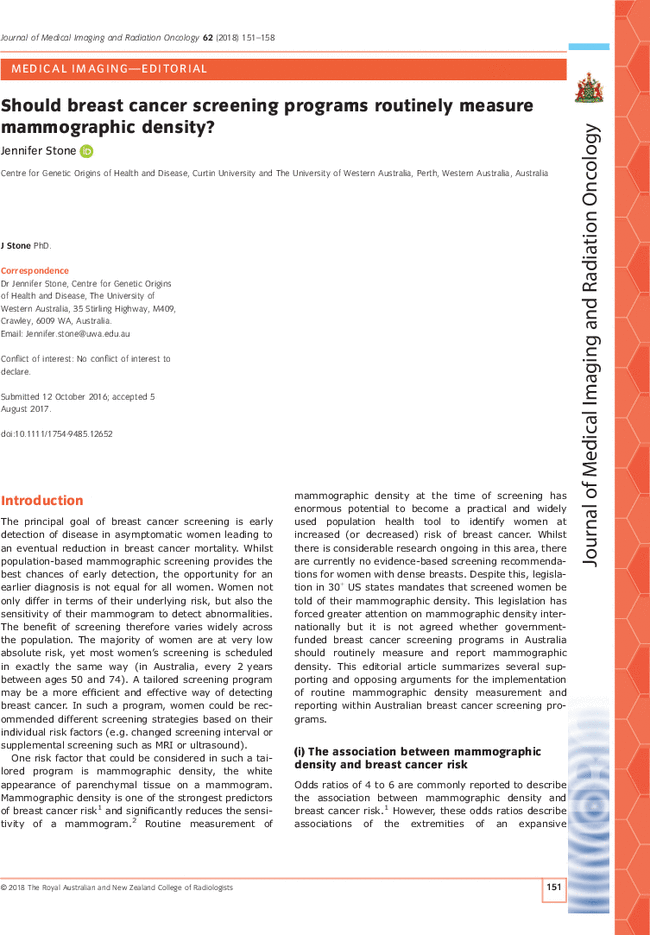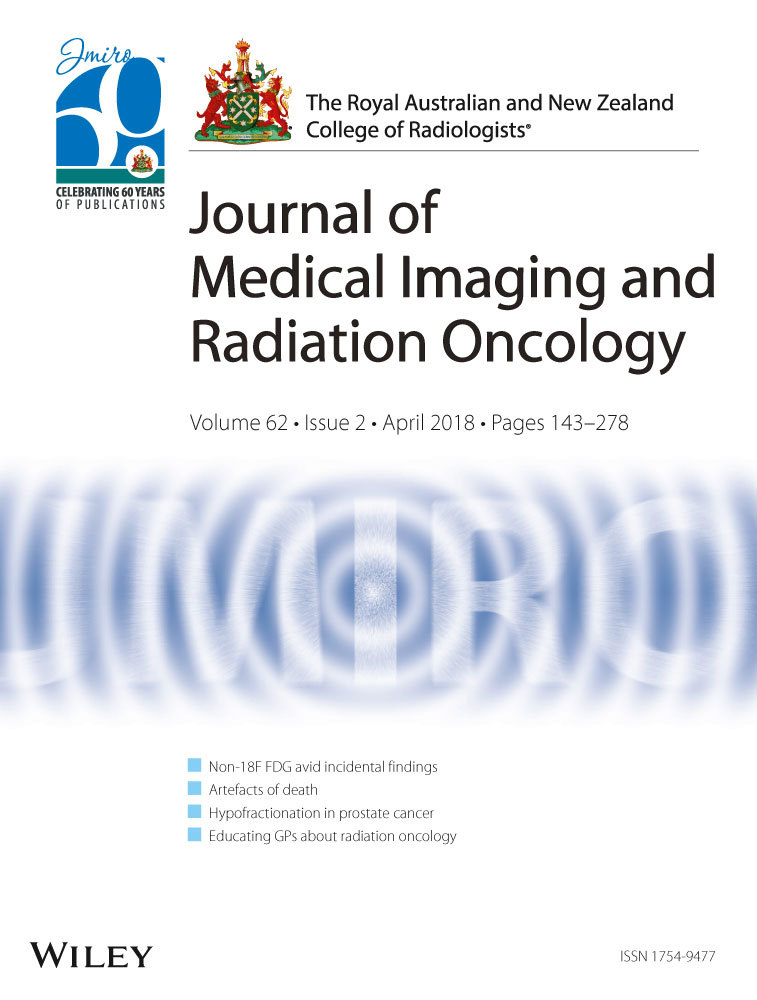Should breast cancer screening programs routinely measure mammographic density?
Corresponding Author
Jennifer Stone
Centre for Genetic Origins of Health and Disease, Curtin University and The University of Western Australia, Perth, Western Australia, Australia
Correspondence
Dr Jennifer Stone, Centre for Genetic Origins of Health and Disease, The University of Western Australia, 35 Stirling Highway, M409, Crawley, 6009 WA, Australia.
Email: [email protected]
Search for more papers by this authorCorresponding Author
Jennifer Stone
Centre for Genetic Origins of Health and Disease, Curtin University and The University of Western Australia, Perth, Western Australia, Australia
Correspondence
Dr Jennifer Stone, Centre for Genetic Origins of Health and Disease, The University of Western Australia, 35 Stirling Highway, M409, Crawley, 6009 WA, Australia.
Email: [email protected]
Search for more papers by this author
References
- 1McCormack VA, Dos Santos Silva I. Breast density and parenchymal patterns as markers of breast cancer risk: a meta-analysis. Cancer Epidemiol Biomarkers Prev 2006; 15: 1159–69.
- 2Kolb TM, Lichy J, Newhouse JH. Comparison of the performance of screening mammography, physical examination, and breast US and evaluation of factors that influence them: an analysis of 27,825 patient evaluations. Radiology 2002; 225: 165–75.
- 3Eng A, Gallant Z, Shepherd J et al. Digital mammographic density and breast cancer risk: a case inverted question markcontrol study of six alternative density assessment methods. Breast Cancer Res 2014; 16: 439.
- 4Hopper JL. Odds per adjusted standard deviation: comparing strengths of associations for risk factors measured on different scales and across diseases and populations. Am J Epidemiol 2015; 182: 863–7.
- 5Meshkat B, Prichard RS, Al-Hilli Z et al. A comparison of clinical-pathological chjmirocteristics between symptomatic and interval breast cancer. Breast 2015; 24: 278–82.
- 6 BreastScreen Australia monitoring report 2014–2015. AIHW: Australian Institute of Health and Welfare, Canberra, 2015; 60–61.
- 7Nickson C, Arzhaeva Y, Aitken Z et al. AutoDensity: an automated method to measure mammographic breast density that predicts breast cancer risk and screening outcomes. Breast Cancer Res 2013; 15: R80.
- 8Boyd NF, Guo H, Martin LJ et al. Mammographic density and the risk and detection of breast cancer. N Engl J Med 2007; 356: 227–36.
- 9Kerlikowske K, Zhu W, Tosteson AN et al. Identifying women with dense breasts at high risk for interval cancer: a cohort study. Ann Intern Med 2015; 162: 673–81.
- 10Evans DG, Howell A. Can the breast screening appointment be used to provide risk assessment and prevention advice? Breast Cancer Res 2015; 17: 84.
- 11Colin C, Schott AM, Valette PJ. Mammographic density is not a worthwhile examination to distinguish high cancer risk women in screening. Eur Radiol 2014; 24: 2412–6.
- 12Yaghjyan L, Colditz GA, Rosner B, Bertrand KA, Tamimi RM. Reproductive factors related to childbearing and mammographic breast density. Breast Cancer Res Treat 2016; 158: 351–9.
- 13Huo CW, Chew GL, Britt KL et al. Mammographic density-a review on the current understanding of its association with breast cancer. Breast Cancer Res Treat 2014; 144: 479–502.
- 14Couto E, Qureshi SA, Hofvind S et al. Hormone therapy use and mammographic density in postmenopausal Norwegian women. Breast Cancer Res Treat 2012; 132: 297–305.
- 15Boyd NF, Dite GS, Stone J et al. Heritability of mammographic density, a risk factor for breast cancer. N Engl J Med 2002; 347: 886–94.
- 16Stone J, Dite GS, Gunasekjmiro A et al. The heritability of mammographically dense and nondense breast tissue. Cancer Epidemiol Biomarkers Prev 2006; 15: 612–7.
- 17Martin LJ, Melnichouk O, Guo H et al. Family history, mammographic density, and risk of breast cancer. Cancer Epidemiol Biomarkers Prev 2010; 19: 456–63.
- 18Stone J, Thompson DJ, Dos Santos Silva I et al. Novel associations between common breast cancer susceptibility variants and risk-predicting mammographic density measures. Cancer Res 2015; 75: 2457–67.
- 19Varghese JS, Thompson DJ, Michailidou K et al. Mammographic breast density and breast cancer: evidence of a shared genetic basis. Cancer Res 2012; 21: 2167–75.
- 20Sprague BL, Gangnon RE, Burt V et al. Prevalence of mammographically dense breasts in the United States. J Natl Cancer Inst. 2014; 106(10).
10.1093/jnci/dju255 Google Scholar
- 21Stone J, Dite G, Giles GG, Cawson J, Hopper J. Inference about causation from elimination of familial confounding: application to longitudinal twin data on mammographic density measures that predict breast cancer risk. Cancer Epidemiol Biomarkers Prev 2012; 21: 1149–55.
- 22Berg WA, Blume JD, Cormack JB et al. Combined screening with ultrasound and mammography vs mammography alone in women at elevated risk of breast cancer. JAMA 2008; 299: 2151–63.
- 23Kuhl CK, Schrading S, Strobel K, Schild HH, Hilgers RD, Bieling HB. Abbreviated breast magnetic resonance imaging (MRI): first postcontrast subtracted images and maximum-intensity projection-a novel approach to breast cancer screening with MRI. J Clin Oncol 2014; 32: 2304–10.
- 24Houssami N, Turner RM. Rapid review: Estimates of incremental breast cancer detection from tomosynthesis (3D-mammography) screening in women with dense breasts. Breast 2016; 30: 141–5.
- 25Rhodes DJ, Hruska CB, Conners AL et al. Journal club: molecular breast imaging at reduced radiation dose for supplemental screening in mammographically dense breasts. AJR 2015; 204: 241–51.
- 26Lee-Felker SA, Tekchandani L, Thomas M et al. Newly diagnosed breast cancer: comparison of contrast-enhanced spectral mammography and breast MR imaging in the evaluation of extent of disease. Radiology 2017; https://doi.org/10.1148/radiol.2017161592
- 27McCormack VA, Perry NM, Vinnicombe SJ, Dos Santos Silva I. Changes and tracking of mammographic density in relation to Pike's model of breast tissue aging: a UK longitudinal study. Int J Cancer 2010; 127: 452–61.
- 28Cuzick J, Warwick J, Pinney E, Warren RM, Duffy SW. Tamoxifen and breast density in women at increased risk of breast cancer. J Natl Cancer Inst 2004; 96: 621–8.
- 29Cuzick J, Warwick J, Pinney E et al. Tamoxifen-induced reduction in mammographic density and breast cancer risk reduction: a nested case-control study. J Natl Cancer Inst 2011; 103: 744–52.
- 30Engmann NJ, Golmakani MK, Miglioretti DL, Sprague BL, Kerlikowske K, Breast Cancer Surveillance Consortium. Population-attributable risk proportion of clinical risk factors for breast cancer. JAMA Oncol 2017; https://doi.org/10.1001/jamaoncol.2016.6326
- 31Nguyen TL, Aung YK, Evans CF et al. Mammographic density defined by higher than conventional brightness thresholds better predicts breast cancer risk. Int J Epidemiol 2016; 46: 652–61.
- 32Nguyen TL, Aung YK, Evans CF et al. Mammographic density defined by higher than conventional brightness threshold better predicts breast cancer risk for full-field digital mammograms. Breast Cancer Res 2015; 17: 142.
- 33Amir E, Freedman OC, Seruga B, Evans DG. Assessing women at high risk of breast cancer: a review of risk assessment models. J Natl Cancer Inst 2010; 102: 680–91.
- 34Amir E, Evans DG, Shenton A et al. Evaluation of breast cancer risk assessment packages in the family history evaluation and screening programme. J Med Genet 2003; 40: 807–14.
- 35Evans DG, Warwick J, Astley SM et al. Assessing individual breast cancer risk within the U.K. National Health Service Breast Screening Program: a new pjmirodigm for cancer prevention. Cancer Prevent Res 2012; 5: 943–51.
- 36Michailidou K, Lindström S, Beesley J et al. Association analysis identifies 65 new breast cancer risk loci. Nature 2017; 551: 92–4.
- 37Milne RL, Kuchenbaecker KB, Michailidou K et al. Identification of ten variants associated with risk of estrogen-receptor-negative breast cancer. Nat Genet 2017; 49: 1767–78.
- 38Antoniou AC, Hardy R, Walker L et al. Predicting the likelihood of carrying a BRCA1 or BRCA2 mutation: validation of BOADICEA, BRCAPRO, IBIS, Myriad and the Manchester scoring system using data from UK genetics clinics. J Med Genet 2008; 45: 425–31.
- 39Trentham-Dietz A, Kerlikowske K, Stout NK et al. Tailoring breast cancer screening intervals by breast density and risk for women aged 50 years or older: collaborative modeling of screening outcomes. Ann Intern Med 2016; 165: 700–12.
- 40Santiago-Rivas M, Benjamin S, Jandorf L. Breast density knowledge and awareness: a review of literature. J Prim Care Community Health 2016; 7: 207–14.
- 41 Are you Dense? United States: Nancy Capella; 2016 [www.areyoudense.org].
- 42 Breast Kept Secret Australia: Kylea Tink & Associates in conjunction with Volpjmiro Solutions Limited; 2016 [www.breastkeptsecret.com.au].
- 43 INformation FORum on Mammographic Density (INFORMD) Australia 2016 [www.informd.org.au].
- 44Yaffe M, Boyd N. Mammographic breast density and cancer risk: the radiological view. Gynecol Endocrinol 2005; 21(Suppl. 1): 6–11.
- 45Alonzo-Proulx O, Mawdsley GE, Patrie JT, Yaffe MJ, Harvey JA. Reliability of automated breast density measurements. Radiology 2015; 275: 366–76.




